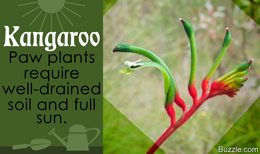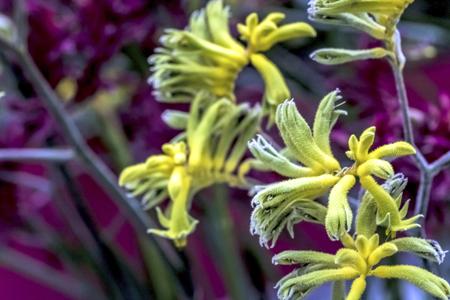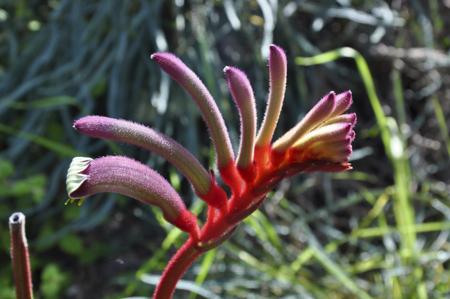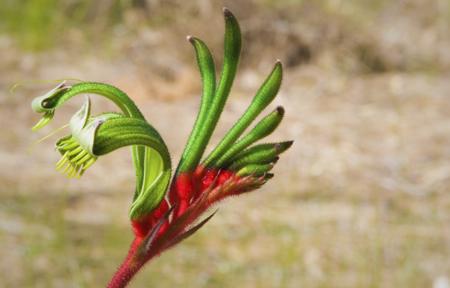





 Did You Know?Most of Australia's flora and fauna have their origins in Gondwana, which broke up into South America, Africa, India, Australia, and Antarctica, about 140 million years ago. Due to its geographic isolation, more than 80 per cent of the country's flowering plants, mammals, reptiles, and frogs are unique to Australia, along with most of its freshwater fish and almost half of its birds.Many species that belong to the family 'Haemodoraceae' are commonly known as 'Kangaroo paw plants', because of their bizarre but colorful flowers that have 'six claw-like structures' at the apex. The flowers are tubular, but open at the apex. They have dense, velvety hair over the tubular structure and open paws. Their 'sword-like' or 'iris-like' structures are known for their 'upright spikes of fuzzy flowers' and 'striking warm colors'. Because of their unique flower structure, they are the most sought-after plants for gardeners all over the world.
Did You Know?Most of Australia's flora and fauna have their origins in Gondwana, which broke up into South America, Africa, India, Australia, and Antarctica, about 140 million years ago. Due to its geographic isolation, more than 80 per cent of the country's flowering plants, mammals, reptiles, and frogs are unique to Australia, along with most of its freshwater fish and almost half of its birds.Many species that belong to the family 'Haemodoraceae' are commonly known as 'Kangaroo paw plants', because of their bizarre but colorful flowers that have 'six claw-like structures' at the apex. The flowers are tubular, but open at the apex. They have dense, velvety hair over the tubular structure and open paws. Their 'sword-like' or 'iris-like' structures are known for their 'upright spikes of fuzzy flowers' and 'striking warm colors'. Because of their unique flower structure, they are the most sought-after plants for gardeners all over the world. Seeds of many species of Anigozanthos are available in the market. If you want to grow plants from seeds, add a seed-raising mix to the pot and sow the seeds in it during spring or summer. Keep the mixture moist and lightly cover the pot until germination occurs. The plants require well-drained soils (sandy soils or loams), and full sun or dappled shade. They will start blooming after a year. When the buds are forming, make sure that the plants are well-watered (they should get at least one inch of water every week). When they are not blooming, they don't need extra water.
Seeds of many species of Anigozanthos are available in the market. If you want to grow plants from seeds, add a seed-raising mix to the pot and sow the seeds in it during spring or summer. Keep the mixture moist and lightly cover the pot until germination occurs. The plants require well-drained soils (sandy soils or loams), and full sun or dappled shade. They will start blooming after a year. When the buds are forming, make sure that the plants are well-watered (they should get at least one inch of water every week). When they are not blooming, they don't need extra water. Autumn is the best season to divide the clumps. See to it that each section contains two or three large shoots. Take suitable containers and plant the sections in well-drained potting mix. See to it that the shoots are at the same level as they were before. Trim all the leaves, leaving about one third of each leaf. To avoid direct sun, place the containers in a sheltered position. You can plant them in your garden, when the new leaves start growing. The roots also would come out of the drainage holes. Add some organic matter to the soil. If you want, you may divide large clumps into 2-3 big sections, and plant them directly at new locations in your garden. See to it that they are well watered until they start growing. The size of the flower stems can be 1.5 - 2 meters.By Tissue Culture
Autumn is the best season to divide the clumps. See to it that each section contains two or three large shoots. Take suitable containers and plant the sections in well-drained potting mix. See to it that the shoots are at the same level as they were before. Trim all the leaves, leaving about one third of each leaf. To avoid direct sun, place the containers in a sheltered position. You can plant them in your garden, when the new leaves start growing. The roots also would come out of the drainage holes. Add some organic matter to the soil. If you want, you may divide large clumps into 2-3 big sections, and plant them directly at new locations in your garden. See to it that they are well watered until they start growing. The size of the flower stems can be 1.5 - 2 meters.By Tissue Culture These days, commercial tissue culture is popular for growing kangaroo paw plants. Horticulturists can develop large numbers of clones of the original plant with the help of tissue culture. Anigozanthos flavidus DC. (tall kangaroo paw) is one of the most robust species that is found in the south western corner of Western Australia. The horticulture industry uses this variety to develop hybrids that grow well in different situations. If you are planning of buying some species, determine the color first, and buy the species in flower. Various hybrid varieties are known for the typical stem size, hardiness, flower color and size, flowering time, etc. Profuse flowering is characteristic of all hybrids.The short-lived plants produce less flowers as they age. Some species are annuals and die in winter, while some are dormant over winter. The plants should be pruned in winter, leaving at least 10 cm above the ground. Cutting the plants is the best way of getting rid of diseased and frost-damaged leaves. When old flower stems start to wither, or when the flowers look less appealing, cut the stems right from the base, along with the leaves. Otherwise, they will blacken and fall off. If the plants become untidy, cut them hard. As you prune the plant, new shoots will emerge at the base of the plant, and will grow quickly and vigorously.Kangaroo Paw: Plant CareThe newer varieties are more disease-resistant. They are easy care plants, but you should remove dead leaves from time to time. As mentioned above, the plants grow well in full sun positions. If they don't get sufficient sunlight, they are likely to develop diseases. The plants can withstand very dry summers as well as moist, cool winters. They can tolerate temperatures over 40°C down to 0°C. But high humidity can lead to rotten roots or crowns. Plants growing in cool and moist climates are more susceptible to diseases.
These days, commercial tissue culture is popular for growing kangaroo paw plants. Horticulturists can develop large numbers of clones of the original plant with the help of tissue culture. Anigozanthos flavidus DC. (tall kangaroo paw) is one of the most robust species that is found in the south western corner of Western Australia. The horticulture industry uses this variety to develop hybrids that grow well in different situations. If you are planning of buying some species, determine the color first, and buy the species in flower. Various hybrid varieties are known for the typical stem size, hardiness, flower color and size, flowering time, etc. Profuse flowering is characteristic of all hybrids.The short-lived plants produce less flowers as they age. Some species are annuals and die in winter, while some are dormant over winter. The plants should be pruned in winter, leaving at least 10 cm above the ground. Cutting the plants is the best way of getting rid of diseased and frost-damaged leaves. When old flower stems start to wither, or when the flowers look less appealing, cut the stems right from the base, along with the leaves. Otherwise, they will blacken and fall off. If the plants become untidy, cut them hard. As you prune the plant, new shoots will emerge at the base of the plant, and will grow quickly and vigorously.Kangaroo Paw: Plant CareThe newer varieties are more disease-resistant. They are easy care plants, but you should remove dead leaves from time to time. As mentioned above, the plants grow well in full sun positions. If they don't get sufficient sunlight, they are likely to develop diseases. The plants can withstand very dry summers as well as moist, cool winters. They can tolerate temperatures over 40°C down to 0°C. But high humidity can lead to rotten roots or crowns. Plants growing in cool and moist climates are more susceptible to diseases.Copyright © www.100flowers.win Botanic Garden All Rights Reserved